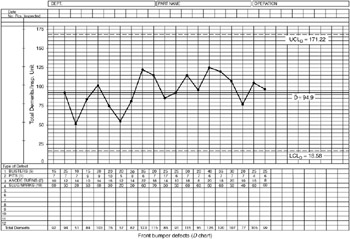THE WEIGHTED NUMBER OF DEFECTS (D) CHART
So far, all of the defects have been of equal value. Here we will assign defect class weights to the number of defects identified. There have been many defect classifications developed for this purpose. However, the most common is the one called the D (defect) chart, which was developed by Dodge and Torrey (1951).
Class A defects ”very serious (100 demerits)
Will make unit unfit for service
Will cause operating failure in service; can't be fixed on the job
Likely to cause personal injury or property damage
Class B defects ”serious (50 demerits)
Likely to cause Class A operating failure in service
Will surely cause trouble of a nature less serious than Class A operating failure
Will surely cause increased maintenance or decreased life
Class C defects ”moderately serious (10 demerits)
May cause operating failure in service
May cause trouble of a nature less serious than operating failure
Major defects of appearance, finish, or workmanship
Class D defects ”not serious (1 demerit)
Will not cause operating failure in service
Minor defects of appearance, finish, or workmanship
First, agree on the defect classification. Those involved could be the producer or supplier and the consumer. Using the control process is easy.
![]() = the mean of the total demerits per inspection unit ( D). The formulas are as follows :
= the mean of the total demerits per inspection unit ( D). The formulas are as follows :
D = w 1 c 1 + w 2 c 2 + ‹ + w k c k
and
The control limits for this chart are defined as:
where
and
Figure 9.17. displays a D chart. The weights assigned to the defects for this chart are:
-
5 points ”blisters
-
1 point ”pits
-
2 points ”anode burns
-
10 points ”slug marks

Figure 9.17: A typical D chart.
EAN: 2147483647
Pages: 181